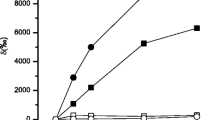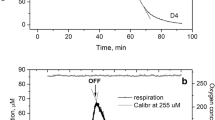Abstract
The usefulness of Fluorinert for the extraction of Acropora formosa polyp tissue and zooxanthellae was demonstrated. The latter remain intact, with no leakage of metabolites, and the polyp tissue can be extracted in a minimal volume. Intact A. formosa and its isolated zooxanthellae were incubated in the light with sodium [14C]bicarbonate for 5 s to 15 min and the kinetics of carbon-14 fixation was determined. The isolated zooxanthellae showed a linear response for carbon fixation, whilst the zooxanthellae in the intact association showed a lag period of 1 to 2 min, containing only 12% of the total fixed carbon in the first 1 min. After 10 min, the distribution of fixed carbon between the symbiotic partners was approximately even and the total carbon fixed was in a range similar to that fixed by the isolated zooxanthellae. A pulse-chase experiment showed rapid movement of fixed carbon from the polyp tissue to the zooxanthellae after the 30 s pulse. The paper discusses two possible explanations for the observed results.
Similar content being viewed by others
Literature cited
Black, C. C. and J. E. Burris: Diurnal carbon-14 partitioning between zooxanthellae and the coral animal tissue of intact Seriatopora hystrix colonies. Mar. Biol. 75, 117–120 (1983)
Cook, C. B.: Metabolic interchange in algae-invertebrate symbiosis. Int. Rev. Cytol. 14, 117–210 (1983)
Davis, P. S.: The role of zooxanthellae in the nutritional energy requirements of Pocillopora eydouxi. Coral Reefs 2, 181–186 (1984)
Heldt, H. W.: Measurement of metabolite movement across the envelope and of the pH in the stroma and the thylakoid space in intact chloroplasts. Methods Enzym. 69, 604–613 (1980)
Holt, von, C. and M. von Holt: Transfer of photosynthetic products from zooxanthellae to coelenterate hosts. Comp. Biochem. Physiol. 24, 73–81 (1968)
Jeffrey, S. W. and F. T. Haxo: Photosynthetic pigments of symbiotic dinoflagellates (zooxanthellae) from corals and clams. Biol. Bull. mar. biol. Lab., Woods Hole 135, 149–165 (1968)
Jeffrey, S. W. and G. F. Humphrey: New spectrophotometric equations for determining chlorophylls a, b, c 1 and c 2 in higher plants, algae and natural phytoplankton. Biochem. Physiol. Pfl. 167, 191–194 (1975)
Johannes, R. E. and W. J. Wiebe: Method for determination of coral tissue biomass and composition. Limnol. Oceanogr. 15, 822–824 (1970)
Lewis, D. H. and D. C. Smith: The autotrophic nutrition of symbiotic marine coelenterates with specific reference to hermatypic corals. I. Movement of photosynthetic products between the symbionts. Proc. R. Soc. (Ser. B) 178, 111–129 (1971)
Lowry, O. H., N. J. Rosebrough, A. L. Farr and R. J. Randall: Protein measurement with the folin phenol reagent. J. biol. Chem. 193, 265–275 (1951)
Mews, L. K.: The green hydra symbiosis. III. The biotrophic transport of carbohydrate from alga to animal. Proc. R. Soc. (Ser. B) 209, 377–401 (1980)
Muscatine, L. and E. Cernichiari: Assimilation of photosynthetic products of zooxanthellae by a reef coral. Biol. Bull. mar. biol. Lab., Woods Hole 137, 506–523 (1969)
Muscatine, L. and J. W. Porter: Reef corals: mutualistic symbioses adapted to nutrient-poor environments. BioSci. 27, 454–460 (1977)
Pearce, V. B. and L. Muscatine: Role of symbiotic algae (zooxanthellae) in coral calcification. Biol. Bull. mar. biol. Lab., Woods Hole 141, 350–363 (1971)
Schmitz, K. and B. P. Kremer: Carbon fixation and analysis of assimilates in a coral-dinoflagellate symbiosis. Mar. Biol. 42, 305–313 (1977)
Trench, R. K.: The physiology and biochemistry of zooxanthellae symbiotic with marine coelenterates. I. The assimilation of photosynthetic products of zooxanthellae by two marine coelenterates. Proc. R. Soc. (Ser. B) 177, 225–235 (1971)
Trench, R. K.: The cell biology of plant-animal symbiosis. Ann. Rev. Pl. Physiol. 30, 485–531 (1979)
Author information
Authors and Affiliations
Additional information
Communicated by G. F. Humphrey, Sydney
Rights and permissions
About this article
Cite this article
Streamer, M., McNeil, Y. & Yellowlees, D. The short-term partitioning of carbon-14 assimilate between zooxanthellae and polyp tissue in Acropora formosa . Mar. Biol. 90, 565–573 (1986). https://doi.org/10.1007/BF00409277
Accepted:
Issue Date:
DOI: https://doi.org/10.1007/BF00409277




